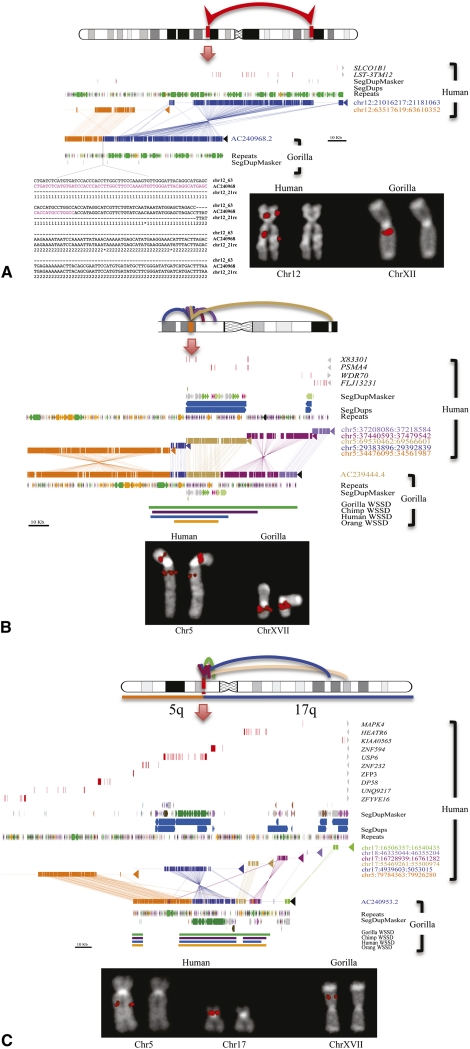Figure 1.
Sequencing of large-scale gorilla chromosome rearrangements. (A) Sequence characterization of a gorilla inversion on chromosome 12 (Egozcue and Chiarelli 1967; Miller et al. 1974). A schematic of the 42.5 Mb inversion (top panel ideogram) is refined by paired-end BES and confirmed by FISH (bottom right panel). A gorilla BAC clone (CH277-205P14) corresponding to the long-arm breakpoint is completely sequenced (AC240968). Miropeats analysis (Parsons 1995) compares two regions on human chromosome 12 (middle panel; blue and orange) with the gorilla sequence. (Repeat elements, LINEs, SINEs, LTRs, SDs, and genes are annotated based on the human genome.) (Bottom left panel) ClustalW alignment pinpoints an AluSx element (purple) at the precise breakpoint. (B) Sequence characterization of a duplicative transposition region in gorilla. (Top panel) A region on chromosome 5p13 near the retinoic acid-induced 14 gene (RAI14) has acquired at least four SDs in the gorilla lineage. (Middle panel) Sequencing of gorilla BAC clone CH277-50D8 (AC239444.4) and Miropeats analysis show SDs ranging in size from 10 to 28 kb along chromosome 5. Read-depth analyses (WSSD tracks) predict that these gorilla duplicative transpositions are focused on a more ancient duplication carrying the spinal muscular atrophy type 4 gene (PSMA4), with flanking duplications becoming increasingly lineage-specific. (Lower panel) FISH analysis with the clone as a probe shows multiple signals. Unique probes proximal and distal to the region indicate no change in the order between human and gorilla. Duplicative transpositions have occurred without a large-scale chromosomal rearrangement. (C) Duplicative transposition at translocation fusion point. (Top panel) Gorilla chromosome XVII arose as a lineage-specific fusion between chromosome 5 and 17 (Stankiewicz et al. 2001). Cloning and sequencing of the breakpoint (CH277-159N16, AC240953) show the presence of a >85 kb complex gorilla-specific duplication block at the breakpoint. The duplication block is a mosaic composed of at least five distinct SDs originating primarily from chromosome 5 (see Supplemental Note for more detail).

